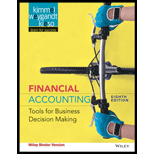
(a)
Assets (A): Assets are those items that provide value for money and future economic benefit for an organization. In simple, it can be referred to as resources possess by a business. Example: Cash, accounts receivable, inventory.
Liabilities (L): Liabilities are debt and obligations of a business. These are the claims of creditors and financial institutions against the resources of the business. Example: Accounts payable, long-term debt, and notes payable.
Expenses (E): Expenses are the costs that the businesses spend to produce and sell the goods and services to the customers or clients. Example: Cost of goods sold, rent expense, and interest expense.
Revenues (R): Revenues are the income or earnings that a business receives for delivering the goods and services. Example: Service revenue, interest revenue, and gain from sale of land.
To identify: whether the given item is an asset (A), Liability (L), Stockholders’ equity (SE), Revenue (R), or Expense (E) item.
(b)
To prepare: An income statement for Company K for the year ended December 31, 2017.
Want to see the full answer?
Check out a sample textbook solution
Chapter 1 Solutions
Financial Accounting 8th Edition
- Monroe Enterprises had beginning total liabilities of $65,000 and ending total liabilities of $85,000. The beginning balance in stockholders' equity was $75,000. During the year, total assets increased by $50,000. In addition, capital stock of $20,000 was issued, and dividends of $10,000 were declared and paid. How much was Monroe’s net income for the year?arrow_forwardWayne Manufacturing estimates that overhead costs for the next year will be $4,200,000 for indirect labor and $540,000 for factory utilities. The company uses machine hours as its overhead allocation base. If 180,000 machine hours are planned for the next year, what is the company's plantwide overhead rate?arrow_forwardI need assistance with this financial accounting question using appropriate principles.arrow_forward
- Please show me how to solve this financial accounting problem using valid calculation techniques.arrow_forwardHii teacher please provide for General accounting question answer do fastarrow_forwardI am looking for the correct answer to this general accounting question with appropriate explanations.arrow_forward
- Principles of Accounting Volume 1AccountingISBN:9781947172685Author:OpenStaxPublisher:OpenStax College
 Financial AccountingAccountingISBN:9781337272124Author:Carl Warren, James M. Reeve, Jonathan DuchacPublisher:Cengage Learning
Financial AccountingAccountingISBN:9781337272124Author:Carl Warren, James M. Reeve, Jonathan DuchacPublisher:Cengage Learning Financial AccountingAccountingISBN:9781305088436Author:Carl Warren, Jim Reeve, Jonathan DuchacPublisher:Cengage Learning
Financial AccountingAccountingISBN:9781305088436Author:Carl Warren, Jim Reeve, Jonathan DuchacPublisher:Cengage Learning


